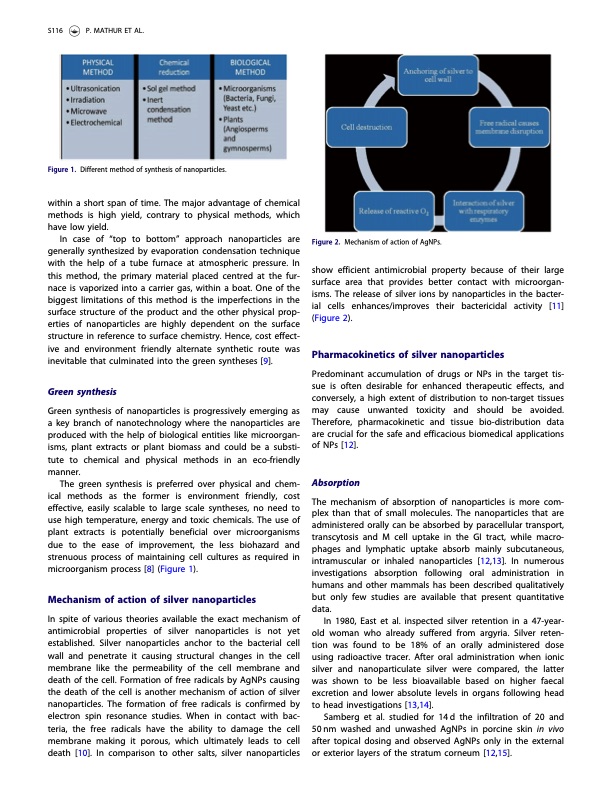
PDF Publication Title:
Text from PDF Page: 003
S116 P. MATHUR ET AL. Figure 1. Different method of synthesis of nanoparticles. within a short span of time. The major advantage of chemical methods is high yield, contrary to physical methods, which have low yield. In case of “top to bottom” approach nanoparticles are generally synthesized by evaporation condensation technique with the help of a tube furnace at atmospheric pressure. In this method, the primary material placed centred at the fur- nace is vaporized into a carrier gas, within a boat. One of the biggest limitations of this method is the imperfections in the surface structure of the product and the other physical prop- erties of nanoparticles are highly dependent on the surface structure in reference to surface chemistry. Hence, cost effect- ive and environment friendly alternate synthetic route was inevitable that culminated into the green syntheses [9]. Green synthesis Green synthesis of nanoparticles is progressively emerging as a key branch of nanotechnology where the nanoparticles are produced with the help of biological entities like microorgan- isms, plant extracts or plant biomass and could be a substi- tute to chemical and physical methods in an eco-friendly manner. The green synthesis is preferred over physical and chem- ical methods as the former is environment friendly, cost effective, easily scalable to large scale syntheses, no need to use high temperature, energy and toxic chemicals. The use of plant extracts is potentially beneficial over microorganisms due to the ease of improvement, the less biohazard and strenuous process of maintaining cell cultures as required in microorganism process [8] (Figure 1). Mechanism of action of silver nanoparticles In spite of various theories available the exact mechanism of antimicrobial properties of silver nanoparticles is not yet established. Silver nanoparticles anchor to the bacterial cell wall and penetrate it causing structural changes in the cell membrane like the permeability of the cell membrane and death of the cell. Formation of free radicals by AgNPs causing the death of the cell is another mechanism of action of silver nanoparticles. The formation of free radicals is confirmed by electron spin resonance studies. When in contact with bac- teria, the free radicals have the ability to damage the cell membrane making it porous, which ultimately leads to cell death [10]. In comparison to other salts, silver nanoparticles Figure 2. Mechanism of action of AgNPs. show efficient antimicrobial property because of their large surface area that provides better contact with microorgan- isms. The release of silver ions by nanoparticles in the bacter- ial cells enhances/improves their bactericidal activity [11] (Figure 2). Pharmacokinetics of silver nanoparticles Predominant accumulation of drugs or NPs in the target tis- sue is often desirable for enhanced therapeutic effects, and conversely, a high extent of distribution to non-target tissues may cause unwanted toxicity and should be avoided. Therefore, pharmacokinetic and tissue bio-distribution data are crucial for the safe and efficacious biomedical applications of NPs [12]. Absorption The mechanism of absorption of nanoparticles is more com- plex than that of small molecules. The nanoparticles that are administered orally can be absorbed by paracellular transport, transcytosis and M cell uptake in the GI tract, while macro- phages and lymphatic uptake absorb mainly subcutaneous, intramuscular or inhaled nanoparticles [12,13]. In numerous investigations absorption following oral administration in humans and other mammals has been described qualitatively but only few studies are available that present quantitative data. In 1980, East et al. inspected silver retention in a 47-year- old woman who already suffered from argyria. Silver reten- tion was found to be 18% of an orally administered dose using radioactive tracer. After oral administration when ionic silver and nanoparticulate silver were compared, the latter was shown to be less bioavailable based on higher faecal excretion and lower absolute levels in organs following head to head investigations [13,14]. Samberg et al. studied for 14d the infiltration of 20 and 50nm washed and unwashed AgNPs in porcine skin in vivo after topical dosing and observed AgNPs only in the external or exterior layers of the stratum corneum [12,15].PDF Image | Artificial Cells, Nanomedicine, and Biotechnology

PDF Search Title:
Artificial Cells, Nanomedicine, and BiotechnologyOriginal File Name Searched:
Pharmaceutical-aspects-silver-nanoparticles.pdfDIY PDF Search: Google It | Yahoo | Bing
Turbine and System Plans CAD CAM: Special for this month, any plans are $10,000 for complete Cad/Cam blueprints. License is for one build. Try before you buy a production license. More Info
Waste Heat Power Technology: Organic Rankine Cycle uses waste heat to make electricity, shaft horsepower and cooling. More Info
All Turbine and System Products: Infinity Turbine ORD systems, turbine generator sets, build plans and more to use your waste heat from 30C to 100C. More Info
CO2 Phase Change Demonstrator: CO2 goes supercritical at 30 C. This is a experimental platform which you can use to demonstrate phase change with low heat. Includes integration area for small CO2 turbine, static generator, and more. This can also be used for a GTL Gas to Liquids experimental platform. More Info
Introducing the Infinity Turbine Products Infinity Turbine develops and builds systems for making power from waste heat. It also is working on innovative strategies for storing, making, and deploying energy. More Info
Need Strategy? Use our Consulting and analyst services Infinity Turbine LLC is pleased to announce its consulting and analyst services. We have worked in the renewable energy industry as a researcher, developing sales and markets, along with may inventions and innovations. More Info
Made in USA with Global Energy Millennial Web Engine These pages were made with the Global Energy Web PDF Engine using Filemaker (Claris) software.
Infinity Turbine Developing Spinning Disc Reactor SDR or Spinning Disc Reactors reduce processing time for liquid production of Silver Nanoparticles.
| CONTACT TEL: 608-238-6001 Email: greg@infinityturbine.com | RSS | AMP |